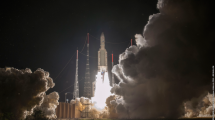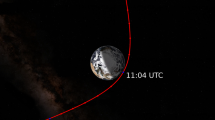Abstract
The Dawn spacecraft is designed to travel to and operate in orbit around the two largest main belt asteroids, Vesta and Ceres. Developed to meet a ten-year life and fully redundant, the spacecraft accommodates an ion propulsion system, including three ion engines and xenon propellant tank, utilizes large solar arrays to power the engines, carries the science instrument payload, and hosts the hardware and software required to successfully collect and transmit the scientific data back to Earth. The launch of the Dawn spacecraft in September 2007 from Cape Canaveral Air Force Station was the culmination of nearly five years of design, development, integration and testing of this unique system, one of the very few scientific spacecraft to rely on ion propulsion. The Dawn spacecraft arrived at its first destination, Vesta, in July 2011, where it will conduct science operations for twelve months before departing for Ceres.























































Similar content being viewed by others
Notes
Frame error rate is used instead of bit error rate because turbo-coding failures result in the loss of the entire code block or data frame.
Abbreviations
- AA:
-
Active Analog
- AC:
-
Attitude Control
- ACE:
-
Attitude Control Electronics
- ACS:
-
Attitude Control Subsystem
- AMBI:
-
Advanced Spaceborne Computer Module Bus Interface
- APE:
-
Attitude and Power Electronics
- ARM:
-
Autonomous Redundancy Management
- ATLO:
-
Assembly, Test, and Launch Operations
- BL:
-
Bi-Level
- BSP:
-
Board Support Package
- CADU:
-
Channel Access Data Units
- CBE:
-
Current Best Estimate
- CCD:
-
Charge-Coupled Device
- CCSDS:
-
Consultative Committee for Space Data Systems
- CDHS:
-
Command and Data Handling Subsystem
- CEU:
-
Central Electronics Unit
- CPT:
-
Comprehensive Performance Test
- CPU:
-
Central Processing Unit
- CTT:
-
Compatibility Test Trailer
- CS:
-
Checksum
- CSS:
-
Coarse Sun Sensor
- DAS:
-
Data Acquisition System
- DCIU:
-
Digital Command Interface Unit
- DI:
-
Diagnostic
- DL:
-
DownLink
- DOD:
-
Depth of Discharge
- DOR:
-
Differential One-way Ranging
- DRAM:
-
Dynamic Random Access Memory
- DS:
-
Data Storage
- DS1:
-
Deep Space 1
- DSN:
-
Deep Space Network
- EEPROM:
-
Electrically-Erasable Programmable Read-Only Memory
- EMC:
-
ElectroMagnetic Compatibility
- EMI:
-
ElectroMagnetic Interference
- EPS:
-
Electrical Power Subsystem
- FEM:
-
Finite Element Model
- FOV:
-
Field of View
- FPA:
-
Fuse Protect Assembly
- FS:
-
Flight System
- FSW:
-
Flight SoftWare
- GALEX:
-
Galaxy Explorer
- GRaND:
-
Gamma Ray and Neutron Detector
- GSFC:
-
Goddard Space Flight Center
- HAMO:
-
High Altitude Mapping Orbit
- HDRM:
-
Hold-Down Release Mechanisms
- HGA:
-
High Gain Antenna
- HLP:
-
Hardware Logic Pulse
- HS:
-
Health and Safety
- HVCE:
-
High Voltage Control Electronics
- HVDC:
-
High Voltage Down Converter
- HVEA:
-
High Voltage Electronics Assembly
- HVRA:
-
High Voltage Relay Assembly
- IPS:
-
Ion Propulsion System
- IRU:
-
Inertial Reference Unit
- ISR:
-
Interrupt Service Routine
- JPL:
-
Jet Propulsion Laboratory
- LGA:
-
Low Gain Antennas
- LILT:
-
Low Intensity/Low Temperature
- LPT:
-
Limited Performance Tests
- LVPS:
-
Low Voltage Power Supply
- KSC:
-
Kennedy Space Center
- LAMO:
-
Low Altitude Mapping Orbit
- MBAR:
-
Main Belt Asteroid Rendezvous
- MLI:
-
Multi-Layer Insulation
- MUC:
-
Mission-Unique Card
- NASA:
-
National Aeronautics and Space Administration
- OBC:
-
On-Board Processor
- OIP:
-
Optional Internal Processor
- OS:
-
Operating System
- OV4:
-
OrbView-4
- PA:
-
Passive Analog
- PAF:
-
Payload Attach Fitting
- PCE:
-
Power Control Electronics
- PDU:
-
Power Distribution Unit
- PPU:
-
Power Processing Unit
- PSP:
-
Priority Status Packet
- P/T:
-
Pressure/Temperature
- PVCDU:
-
Partial Virtual Channel Data Units
- RAM:
-
Random Access Memory
- RCS:
-
Reaction Control Subsystem
- RDF:
-
Radiation Design Factor
- REA:
-
Reaction Engine Assembly
- ROM:
-
Read-Only Memory
- RTS:
-
Relative Time Sequence
- RWA:
-
Reaction Wheel Assembly
- S/A:
-
Solar Array
- SAD:
-
Solar Array Drive
- SADA:
-
Solar Array Drive Assemblies
- SADE:
-
Solar Array Drive Electronics
- SAS:
-
Solar Array Simulator
- SB:
-
Software Bus
- SC:
-
Stored Command
- S/C:
-
Spacecraft
- SDST:
-
Small Deep Space Transponder
- SEFI:
-
Single Event Functional Interrupt
- SEU:
-
Single Event Upset
- SM:
-
Software Manager
- SMF:
-
Satellite Manufacturing Facility
- SORCE:
-
Solar Radiation and Climate Experiment
- SRAM:
-
Static RAM
- STs:
-
Star Trackers
- STM:
-
Structural Test Model
- SUROM:
-
Start-Up ROM
- TA:
-
Telemetry Agent
- TARA:
-
Two-Axis Rate Assembly (inertial reference unit)
- TC:
-
Time Code
- TCXO:
-
Temperature-Controlled Crystal Oscillator
- TEC:
-
Thermal Electric Cooler
- TG:
-
Telemetry Gatherer
- TGA:
-
Thruster Gimbal Assembly
- TMON:
-
Telemetry Monitor
- TO:
-
Telemetry Output
- TP:
-
Thermal Processor
- TQCM:
-
Temperature Controlled Quartz Crystal Microbalance
- TS:
-
Telemetry and Statistics
- TVAC:
-
Thermal Vacuum
- TVC:
-
Thrust Vector Control
- TWTA:
-
Traveling Wave Tube Amplifiers
- UL:
-
Uplink
- VCDU:
-
Virtual Channel Data Units
- VCID:
-
Virtual Channel Identifiers
- VIR:
-
Visible and InfraRed mapping spectrometer
- VM:
-
Virtual Machine
- VML:
-
Virtual Machine Language
- VR:
-
Virtual Recorder
- V/T:
-
Voltage/Temperature
- WDT:
-
Watch Dog Timer
Acknowledgements
The authors wish to express their appreciation all the individuals at JPL, Orbital Sciences Corporation and their many subcontractors, whose hard work and dedication contributed to getting the Dawn spacecraft off the ground and on its voyage. The work described in this paper was carried out at the Jet Propulsion Laboratory, California Institute of Technology, under a contract with the National Aeronautics and Space Administration.
Author information
Authors and Affiliations
Corresponding author
Rights and permissions
About this article
Cite this article
Thomas, V.C., Makowski, J.M., Brown, G.M. et al. The Dawn Spacecraft. Space Sci Rev 163, 175–249 (2011). https://doi.org/10.1007/s11214-011-9852-2
Received:
Accepted:
Published:
Issue Date:
DOI: https://doi.org/10.1007/s11214-011-9852-2




